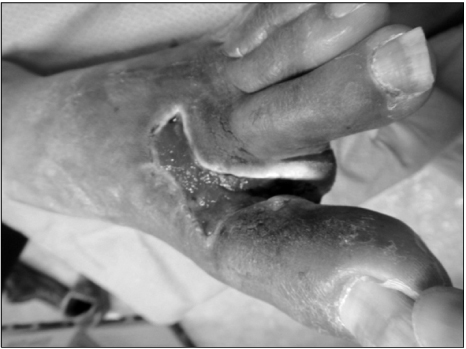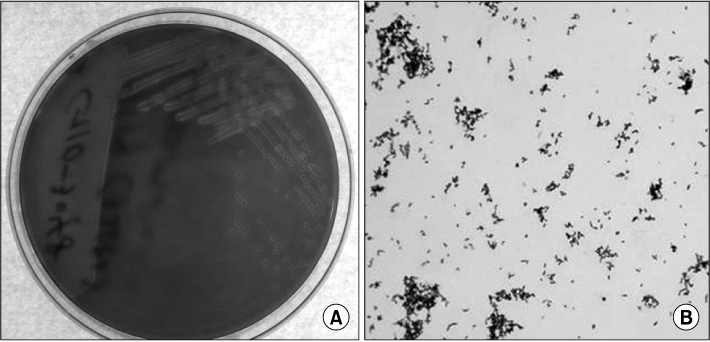Korean J Clin Microbiol.
2012 Dec;15(4):143-146. 10.5145/KJCM.2012.15.4.143.
A Case of Diabetic Foot Ulcer Caused by Arcanobacterium haemolyticum and Streptococcus agalactiae
- Affiliations
-
- 1Department of Laboratory Medicine, Chonbuk National University Medical School, Jeonju, Korea. leehs@jbnu.ac.kr
- 2Research Institute of Clinical Medicine of Chonbuk National University-Biomedical Research Institute of Chonbuk National University Hospital, Jeonju, Korea.
- 3Chonbuk National University Hospital Culture Collection for Pathogens, Jeonju, Korea.
- KMID: 1431811
- DOI: http://doi.org/10.5145/KJCM.2012.15.4.143
Abstract
- Arcanobacterium haemolyticum, a aerobic Gram-positive rod, has been described as an unusual pathogen causing soft tissue infections such as pharyngotonsillitis, chronic ulcer and cellulitis. In addition, the microorganism causes deep-seated infection and systemic disease including endocarditis, vertebral osteomyelitis and sepsis in patients with predisposing conditions such as diabetes mellitus. Since colonies and microscopic findings of A. haemolyticum might be confused with those of streptococci and coryneform bacteria, and it is usually isolated with other microorganisms, it is often considered to be normal flora or a contaminant in wound infections, resulting in missed or delayed diagnosis. Streptococcus agalactiae infections in neonates and pregnant women have been well recognized. However, invasive S. agalactiae infections in non-pregnant older adults with chronic medical conditions, particularly diabetes mellitus, are increasing. We report a case of diabetic foot ulcer due to A. haemolyticum and S. agalactiae in an uncontrolled diabetes mellitus patient.
MeSH Terms
Figure
Reference
-
1. Mancini L, Ruotolo V. The diabetic foot: epidemiology. Rays. 1997. 22:511–523.2. Roberts AD, Simon GL. Diabetic foot infections: the role of microbiology and antibiotic treatment. Semin Vasc Surg. 2012. 25:75–81.3. Kim YC, Kim JS, Park JY, Kang SH, Cho HC, Bang JW, et al. Five cases of Arcanobacterium haemolyticum isolated from skin ulcer and peritonsillar abscess. Korean J Lab Med. 2004. 24:392–395.4. Lee S, Roh KH, Kim CK, Yong D, Choi JY, Lee JW, et al. A case of necrotizing fasciitis due to Streptococcus agalactiae, Arcanobacterium haemolyticum, and Finegoldia magna in a dog-bitten patient with diabetes. Korean J Lab Med. 2008. 28:191–195.5. Dobinsky S, Noesselt T, Rücker A, Maerker J, Mack D. Three cases of Arcanobacterium haemolyticum associated with abscess formation and cellulitis. Eur J Clin Microbiol Infect Dis. 1999. 18:804–806.6. Alós JI, Barros C, Gómez-Garcés JL. Endocarditis caused by Arcanobacterium haemolyticum. Eur J Clin Microbiol Infect Dis. 1995. 14:1085–1088.7. Tan TY, Ng SY, Thomas H, Chan BK. Arcanobacterium haemolyticum bacteraemia and soft-tissue infections: case report and review of the literature. J Infect. 2006. 53:e69–e74.8. Jun KR, Chun SH, Park SJ, Kim DJ, Bae HG, Kim MN. A case of Arcanobacterium haemolyticum sepsis. Korean J Lab Med. 2005. 25:56–60.9. Bae SY, Choi S, Kang SJ, Jang HC, Park KH, Jung SI, et al. A case of Arcanobacterium haemolyticum bacteremia and osteomyelitis diagnosed by 16s rRNA sequencing. Infect Chemother. 2010. 42:241–243.10. Farley MM. Group B streptococcal disease in nonpregnant adults. Clin Infect Dis. 2001. 33:556–561.11. Goyal R, Singh NP, Mathur M. Septic arthritis due to Arcanobacterium haemolyticum. Indian J Med Microbiol. 2005. 23:63–65.12. Konemm EW, Allen SD, editors. Color Atlas and Textbook of Diagnostic Microbiology. 1997. 6th ed. Philadelphia: Lippincott Williams and Wilkins Company;684–685.13. Linder R. Rhodococcus equi and Arcanobacterium haemolyticum: two "coryneform" bacteria increasingly recognized as agents of human infection. Emerg Infect Dis. 1997. 3:145–153.14. Nyman M, Banck G, Thore M. Penicillin tolerance in Arcanobacterium haemolyticum. J Infect Dis. 1990. 161:261–265.15. Altrichter Loan C, Legout L, Assal M, Rohner P, Hoffmeyer P, Bernard L. Severe Streptococcus agalactiae infection of the diabetic foot. Presse Med. 2005. 34:491–494.
- Full Text Links
- Actions
-
Cited
- CITED
-
- Close
- Share
- Similar articles
-
- A Case of Necrotizing Fasciitis Due to Streptococcus agalactiae, Arcanobacterium haemolyticum, and Finegoldia magna in a Dog-bitten Patient with Diabetes
- Five Cases of Arcanobacterium haemolyticum Isolated from Skin Ulcer and Peritonsillar Abscess
- Lemierre Syndrome Caused by Arcanobacterium haemolyticum Alone in a Healthy Man
- Two Cases of Invasive Infections Caused by Arcanobacterium haemolyticum in Immunocompetent Adult
- A Case of Arcanobacterium haemolyticum Sepsis




